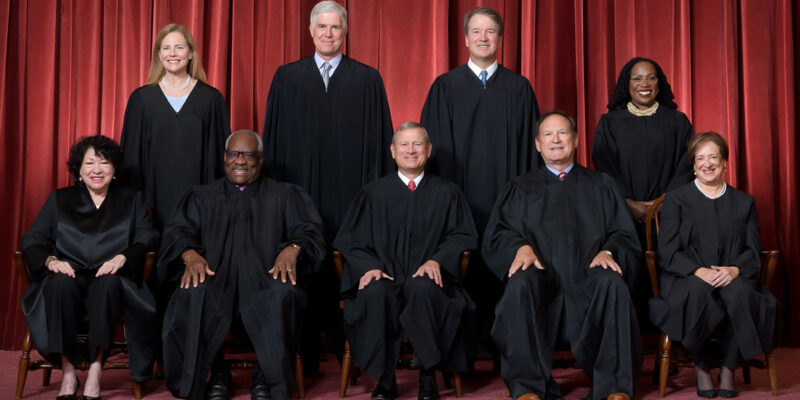The federal Supreme Court came to the right conclusion in its majority opinion for United States v Skrmetti, which involved Tennessee’s law banning trans drugs and surgeries for minors. However, as we have seen in other cases, there are worrisome elements in the majority’s ruling that complicate what is otherwise a reason for celebration.
We begin with Chief Justice Roberts’s (who penned the ruling for the majority) bizarre attempt to sunder and separate pregnancy from womanhood:
‘In Geduldig v. Aiello, 417 U. S. 484 (1974), for example, we held that a California insurance program that excluded from coverage certain disabilities resulting from pregnancy did not discriminate on the basis of sex. See id., at 486, 492–497. In reaching that holding, we explained that the program did not exclude any individual from benefit eligibility because of the individual’s sex but rather “remove[d] one physical condition—pregnancy—from the list of compensable disabilities.” Id., at 496, n. 20. We observed that the “lack of identity” between sex and the excluded pregnancy-related disabilities became “clear upon the most cursory analysis.” Id., at 497, n. 20. The California insurance program, we explained, divided potential recipients into two groups: “pregnant women and nonpregnant persons.” Ibid. Because women fell into both groups, the program did not discriminate against women as a class. See id., at 496, and n. 20. We thus concluded that, even though only biological women can become pregnant, not every legislative classification concerning pregnancy is a sex-based classification.’
Pregnancy is a ‘physical condition’ that can somehow become detached from ‘sex-based classification.’ He even throws in a nonsense term like ‘nonpregnant persons.’ This kind of language and reasoning is not all that different from the hard Left’s use of inclusive terminology like ‘birthing persons.’ The Chief Justice is potentially opening the door for future sexual confusion and federal judicial mischief by abstracting what clearly pertains to one sex, pregnancy, from that particular sex, from women.
Such concerns are not merely speculative. Justice Sotomayor in her dissent details how the federal Supreme Court, through its redefinition of words, norms, etc., has re-shaped the culture of the States in recent years:
‘Indeed, judicial scrutiny has long played an essential role in guarding against legislative efforts to impose upon individuals the State’s views about how people of a particular sex (or race) should live or look or act. Women, it was once thought, were not suited to attend military schools with men. Virginia, 518 U. S., at 520–523, 540–541. Men and women, others said, should not marry those of a different race. Loving, 388 U. S., at 4. Those laws, too, posed politically fraught and contested questions about race, sex, and biology. In a passage that sounds hauntingly familiar to readers of Tennessee’s brief, Virginia argued in Loving that, should this Court intervene, it would find itself in a “bog of conflicting scientific opinion upon the effects of interracial marriage, and the desirability of preventing such alliances, from the physical, biological, genetic, anthropological, cultural, psychological, and sociological point of view.” Brief for Appellee in Loving v. Virginia, O. T. 1966, No. 395, p. 7. “In such a situation,” Virginia continued, “it is the exclusive province of the Legislature of each State to make the determination for its citizens as to the desirability of a policy of permitting or preventing such [interracial] alliances—a province which the judiciary may not constitutionally invade.” Id., at 7–8.
‘This Court, famously, rejected the States’ invitation in Loving to “defer to the wisdom of the state legislature” based on assertions that “the scientific evidence is substantially in doubt.” 388 U. S., at 8. In considering the constitutionality of Virginia’s male-only military academy, too, the Court itself assessed the “opinions of Virginia’s expert witnesses” that “‘[m]ales tend to need an atmosphere of adversativeness,’” while “‘[f]emales tend to thrive in a cooperative atmosphere.’”’
The current makeup of the federal Supreme Court does not inspire confidence that it will resist the temptation to further engage in social engineering. Justice Gorsuch gave us the awful Bostock decision; Chief Justice Roberts has taken on the role of moderate swing vote; and Justice Barrett is looking unreliable as well:
‘The data is out and it looks like MAGA was right about Justice Amy Coney Barrett
‘She’s a backstabber to the people who appointed her
‘The records show her agreeing with liberal justices Sonia Sotomayor and Elena Kagan 82% of the time during her 2nd term, up from 39% in her 1st’ (‘The data doesn’t lie — Amy Coney Barrett is a bigger backstabber than we realized…,’ DC Draino via revolver.news).
The worst part of the majority’s ruling, however, is its lack of any solid principles upon which they ground it. Due to the uncertainty of ‘the science’ surrounding trans procedures for minors, they simply defer to the elected officials of the States. This is dangerous territory, for scientific procedures could one day become advanced enough to manipulate even the genes involved in sex determination. We have nearly reached the point where two men can have children without a woman donating an egg:
‘New research from Oregon Health & Science University describes the science behind a promising technique to treat infertility by turning a skin cell into an egg that is capable of producing viable embryos.
‘ . . . The technique could be used by women of advanced maternal age or those who are unable to produce viable eggs due to previous treatment for cancer or other causes. It also raises the possibility of men in same-sex relationships having children who are genetically related to both parents’ (Erik Robinson, ‘Research sheds light on new strategy to treat infertility,’ ohsu.edu).
More to the point, scientists have been able to use CRISPR to manipulate the sex of mice (here and here) and crustaceans.
When (probably not if) scientists are able to completely transition a man to a woman or a girl to a boy without physical harm, what will stand in the way of the federal Supreme Court from pronouncing that it is ‘invidious sex discrimination’ (to use Chief Justice Roberts’s words) to deny minors or anyone else access to transgender care? The justices will have no defense; by the rules the majority is using (the uncertainty of the science, the inability to identify transgender individuals as a distinct class of people), they would have to acquiesce to the trans cult and strike down laws that prevent minors from transitioning.
Unless they change their approach. While atheistic natural science has been placed at the top of the epistemological hierarchy in recent years, there is actually a higher level of knowledge and authority: divinely revealed and established truth. Until recent years, the latter has always been the lodestar of the South. Richard Weaver explains:
‘Man cannot live under a settled dispensation if the postulates of his existence must be continually revised in accordance with knowledge furnished by a nature filled with contingencies. Nature is a vast unknown; in the science of nature there are constantly appearing emergences which, if allowed to affect spiritual and moral verities, would destroy them by rendering them dubious, tentative and conflicting. It is therefore imperative in the eyes of the older religionists that man have for guidance in this life a body of knowledge to which the facts of natural discovery are either subordinate or irrelevant. This body is the “rock of ages,” firm in the vast sea of human passion and fallibility. Moral truth is not something which can be altered every time science widens its field of induction. If moral philosophy must wait upon natural philosophy, all moral judgments become temporary, relative, and lacking in those sanctions which alone make them effective, as the more perspicacious Southern theologians pointed out’ (The Southern Tradition at Bay, eds. Bradford and Core, Regnery Gateway, Washington, D. C., 1989, p. 90).
The often-changing facts of scientific investigation and theorizing are not safe guides for society. Something more consistent is necessary. Southerners, per Weaver, and other peoples of the West once looked to Christianity for certainty, for answers to complex and difficult questions that arose in life. That is what we must return to in the States if we are going to vanquish the transgender ideology.
Christianity is inseparable from English common law, as admitted by many leading jurists on that subject. And English common law is the basis for the legal systems of the 50 States and their federal government. A Christ-anchored legal system will tell us that there are only two sexes that must not be changed, even if modern science gives us the ability to do so. Christian States will likewise understand that it is not ‘invidious sex discrimination’ to ban transitioning of the sexes but rather a blessing for men and women to live within the order established by the All-Holy Trinity.
The Roberts court has given the States a reprieve from the advances of the faux scientifically-powered transgender juggernaut – for now. But without an epistemological switch from science to Christianity, neither they, nor anyone else, will be able to restrain its advance. The re-baptism of the West is our only hope of escaping from dreadful cataclysms like the transgender revolution in the long run.
Advertisement
Advertisement

